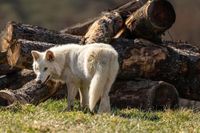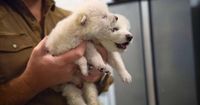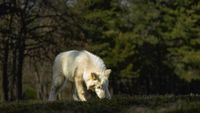On April 7, 2025, Colossal Biosciences, a Texas-based startup, made headlines worldwide by announcing the recreation of giant prehistoric wolves, also known as dire wolves (Aenocyon dirus). This ambitious project is part of a broader initiative to bring back extinct species, a controversial practice referred to as "de-extinction." Colossal Biosciences celebrated this milestone on social media, stating, "This moment marks not only an important step for our company but also a leap forward for science, conservation, and humanity."
The concept of de-extinction has gained traction in recent years, fueled by advances in genetics and synthetic biology. Colossal Biosciences has previously garnered attention for its efforts to resurrect woolly mammoths by genetically modifying Asian elephant cells to incorporate traits from the extinct species. The company aims to reintroduce these genetically modified animals to Siberia, where they hope to restore an ecosystem that has been disrupted. According to Colossal, woolly mammoths played a crucial role in the ecosystem known as the "mammoth steppe," and their reintroduction could potentially help mitigate climate change by preserving the Arctic permafrost, a significant carbon reservoir.
Recently, Colossal Biosciences showcased images of three young dire wolves with thick white fur, born in October 2024 and January 2025. The company claims these are the first living examples of the extinct species, which vanished over 10,000 years ago. The announcement has sparked excitement, particularly given the cultural popularity of dire wolves, thanks in part to the television series "Game of Thrones." The wolves, named Romulus, Remus, and Khaleesi, are the product of a genetic modification process that involved extracting and analyzing DNA from ancient remains, including a 13,000-year-old tooth and a 72,000-year-old skull fragment.
However, experts are cautious about the implications of Colossal's claims. Nadir Alvarez, a professor at the University of Geneva, pointed out that the creatures are not true dire wolves but genetically modified gray wolves (Canis lupus) with only a handful of genes altered to mimic certain characteristics of their ancient counterparts. "After more than 10,000 years of absence, our team is proud to restore the giant wolf to its rightful place in the ecosystem," Colossal's website boasts. Yet, Alvarez counters, "Let’s call a spade a spade. These are genetically modified gray wolves."
The scientific community remains divided on the concept of de-extinction. While some researchers hail the potential benefits of reviving lost species, many express concern about the unrealistic expectations surrounding such projects. Critics argue that focusing on de-extinction diverts attention and resources from urgent conservation efforts aimed at protecting currently endangered species. Colossal Biosciences itself cites the looming threat of mass extinction as a justification for their work, claiming, "The problem is more than enormous; it is human. And the solution is just as significant: the science of de-extinction."
Despite the ambitious claims made by Colossal, many scientists, including paleontologist Nic Rawlence from the University of Otago in New Zealand, remain skeptical. Rawlence emphasized that the notion of de-extinction is fraught with challenges, noting that the genetic material used by Colossal is highly fragmented and cannot truly recreate an extinct species. "What we have is a gray wolf that resembles a dire wolf, nothing more, nothing less," he stated.
Colossal Biosciences's CEO, Ben Lamm, along with Harvard geneticist George Church, has spearheaded the company's de-extinction initiatives, which have garnered significant financial backing. In early 2025, Colossal raised $200 million, leading to a valuation of $10.2 billion. This valuation reflects investor confidence in the potential of de-extinction technology, despite the lack of revenue generated by the company.
As Colossal sets its sights on reviving other extinct species, such as the woolly mammoth and the thylacine (Tasmanian tiger), ethical questions arise. Many conservationists, including Alain Branchaud, director of the Société pour la nature et les parcs in Quebec, argue that resources would be better spent on protecting existing endangered species rather than attempting to resurrect those that have already vanished. Branchaud warns that the habitats and ecosystems that once supported these species have evolved or disappeared, making reintroduction potentially problematic.
Colossal's work raises significant ethical considerations about the role of technology in addressing environmental crises. Critics argue that the focus on de-extinction creates the illusion that we can simply fix past mistakes without addressing the root causes of biodiversity loss. The consensus among many scientists is that while genetic engineering holds promise for various applications, it should not be viewed as a panacea for the current biodiversity crisis.
As the debate continues, the three dire wolf cubs, Romulus, Remus, and Khaleesi, remain under close observation in a secure 800-hectare facility. While they may represent a fascinating scientific endeavor, the reality of their existence prompts important questions about the future of conservation and the ethical implications of playing god with nature.
In the end, the story of Colossal Biosciences and its genetically modified wolves serves as a reminder of the complexities surrounding de-extinction, the responsibilities of modern science, and the urgent need to protect the biodiversity that still exists on our planet.









